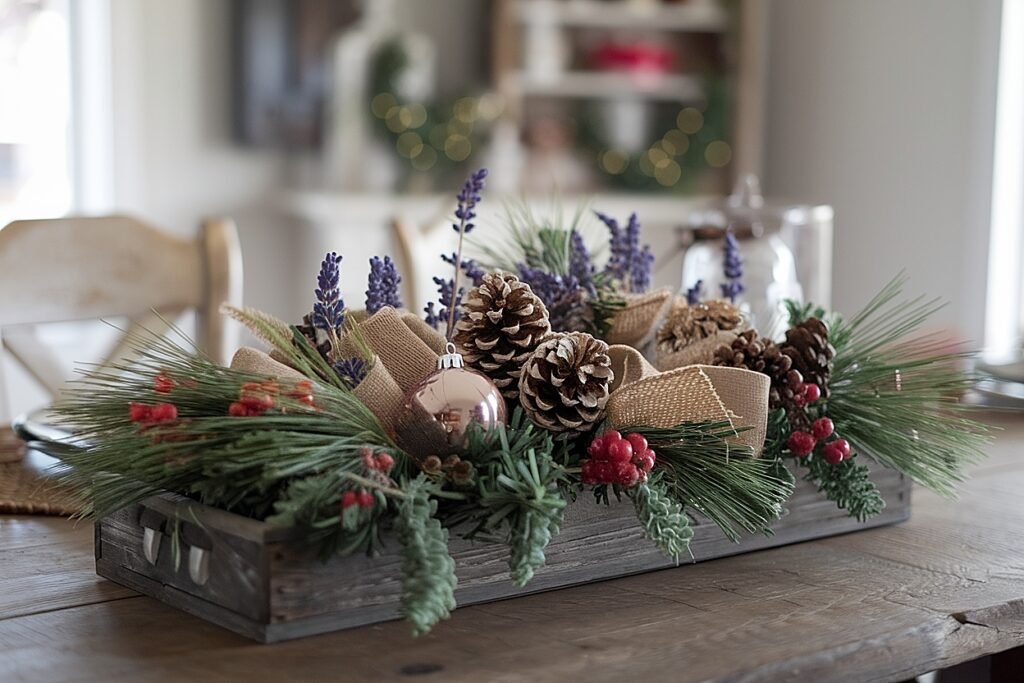
This website contains affiliate links, and some products are gifted by the brand to test. As an Amazon Associate, I earn from qualified purchases. Some of the content on this website was researched and created with the assistance of AI technology.
Key Takeaways
- Keep the bones, swap the accents: preserve your lavender lines and base mechanics, then layer in evergreen, pinecones, and winter metal tones.
- Lower the scent, raise the glow: shift from harvest warmth to winter shimmer with unscented candles, mercury glass, and tight, cool lighting angles.
- Edit in sections: convert centerpieces, windows, and buffets as modular zones so the room feels cohesive while you work in stages.
Transitioning Lavender Thanksgiving Decor for Christmas starts with restraint. I don’t tear everything down; I evolve it. Lavender already carries calm, line, and that soft herbal whisper. Christmas asks for depth, sparkle, and evergreen backbone. When I merge them, the room stops smelling like leftovers and starts breathing winter—without losing the serenity we worked hard to create in November.
I’ve done this in small city apartments and big farmhouse rooms. The rule holds: keep what behaves, replace what shouts “harvest.” Corn husks and pumpkins step aside. Cedar tips, pinecones, and a controlled metallic palette step in. Lavender stays, just quieter—tucked, not trumpeting—so the space reads intentional, not seasonal whiplash.
Lavender → Christmas: 5 Master Themes
Quickly scan the journey from Thanksgiving lavender to Rustic Farmhouse Christmas. Table on larger screens; tap-to-expand accordion on phones.
| Theme | Focus Areas | Furniture & Windows | Pro Tips |
|---|---|---|---|
|
1) Preparation PlanSwap |
|
|
|
|
2) Layering TextureLight |
|
|
|
|
3) Furniture & Displays FlowCohesion |
|
|
|
|
4) Lighting & Scent GlowAroma |
|
|
|
|
5) Guest & Finish HostPolish |
|
|
|
1) Preparation
- Convert centerpieces; choose evergreen varieties.
- Use burlap, twine; replace pumpkins with pinecones.
- Stage near windows; keep materials cohesive.
2) Layering
- Warm LEDs through garlands; diffuse daylight with sheers.
- Adopt winter palette; add refined finishing touches.
- Alternate matte wood with soft linen and glass.
3) Furniture & Displays
- Windows, sideboards, mantels: repeat lavender-pine motifs.
- Use mirrors for depth; leave buffet serving space.
- Keep eye-level sightlines clean and calm.
4) Lighting & Scent
- Layer candles with LEDs; reflect glow off wood.
- Scent: lavender, pine, cinnamon—always subtle.
- Plan photo angles while staging lights.
5) Guest & Finish
- Sachets and name tags for guests; clear pathways.
- Integrate lavender into table settings and traditions.
- Final golden-hour shoot; relight candles before dinner.
How to Transition a Lavender Thanksgiving Centerpiece into a Christmas Display
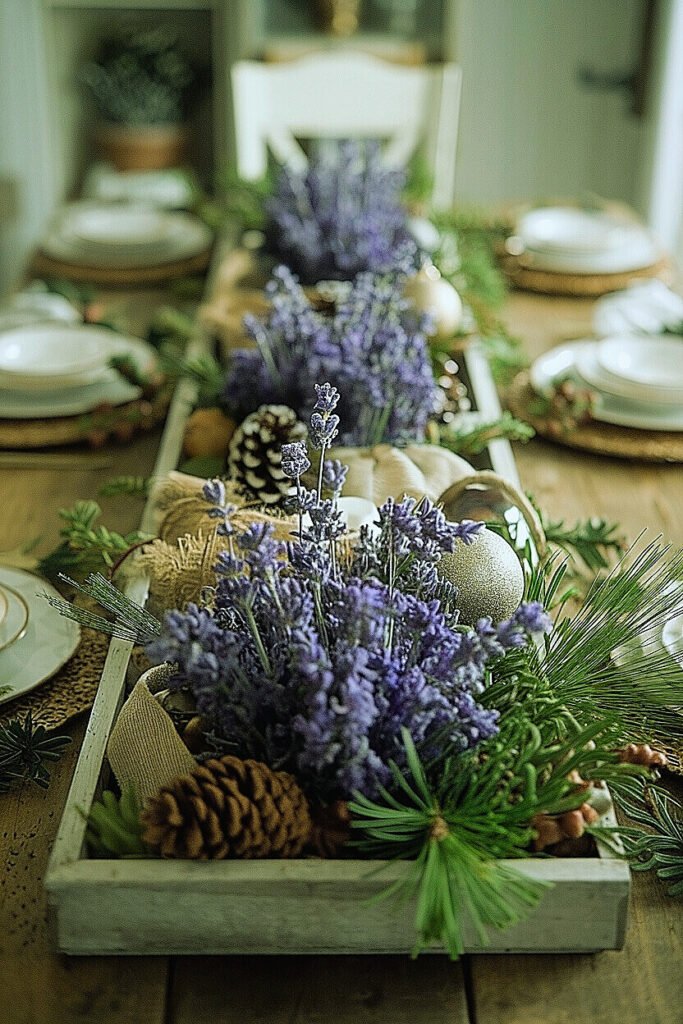
I begin by auditing the mechanics. If your centerpiece rides on jute, chicken wire ribbon, or an olive runner, keep that base. I remove wheat, gourds, and any food-adjacent accents. I shorten visible lavender bundles, burying stems deeper so scent softens and the line remains. Then I add short fir or cedar tips along the spine to thicken shadow and invite candle glow to pool rather than blast.
Next, I shift surfaces. Out go matte harvest plates under candles; in come mercury cups, frosted glass, or pewter saucers—cool reflectors that make lavender’s blue-violet bloom feel wintery. I sprinkle a handful of tiny pinecones at intervals, never rolling loose. If I want a focal, I crown the center with a low glass cloche and a single ornament on linen, ringed by micro lavender. The language changes from rustic abundance to quiet brilliance.
Strip harvest, recess lavender, and layer short evergreen tips; replace warm, porous accents with reflective metals and glass; add restrained pinecone punctuation and a low winter focal. There’s more to dial in—keep reading to choose evergreens that flatter lavender’s tone and texture. For step-by-step garland mechanics you can adapt, see Create a Lavender and Corn Husk Thanksgiving Table Garland, and if this helps, share it with friends who love a calm, fragrant holiday shift.
What Are the Best Evergreens to Pair with Lavender Thanksgiving Decor
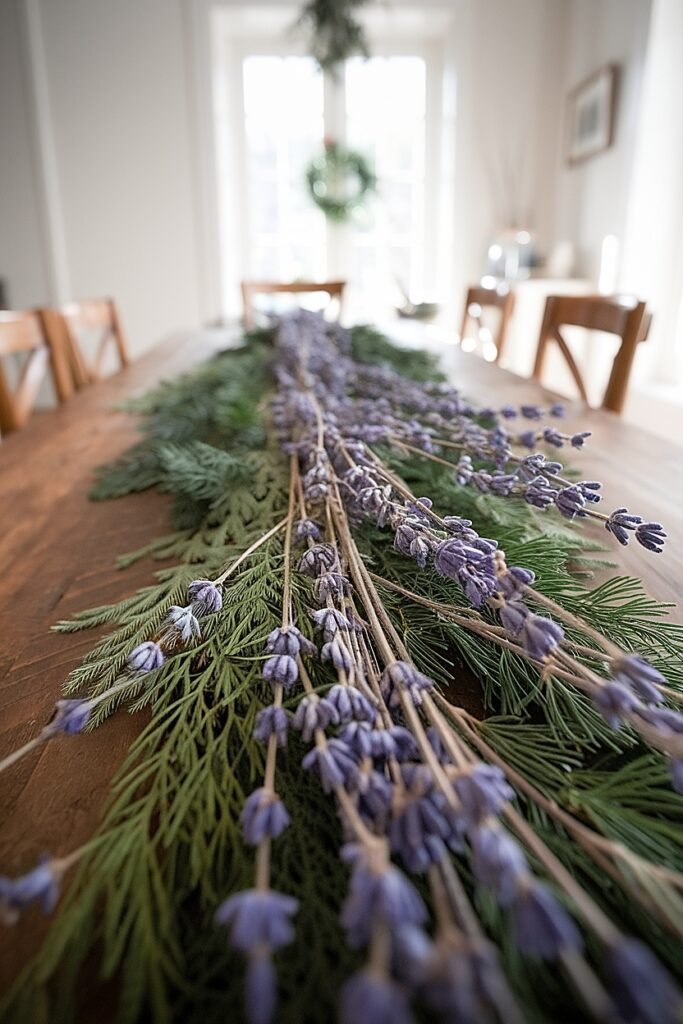
- Cedar (incense or Port Orford):
Cedar lays like silk and photographs beautifully. Its flat, lacy sprays create a soft shadow line that lets lavender’s buds read as texture, not clutter. I cut cedar short—3 to 5 inches—and stitch pieces under lavender arcs so the greenery peeks without spiking height. Cedar’s aroma is gentle and blends well with lavender; it never bullies. It also holds color indoors, which matters if your dining area runs warm. Mist lightly before guests arrive to revive tone. - Noble Fir:
When I need structure, noble fir is my quiet muscle. The needles sit tidy, the color leans cool, and the boughs resist droop across long runs. I reserve it for edges and corners where traffic brushes, because it withstands sleeves better than cedar. Pairing noble fir with lavender shifts the palette into alpine calm. Trim needles back where people reach, and thread short lavender bundles over cut ends to keep mechanics invisible and skin safe. Glow handles the rest. - Juniper (with berries):
Juniper’s dusky-blue berries echo lavender’s bloom without duplication. I use it sparingly for a winter wink: two knuckles of juniper near the centerpiece center, another at the sideboard’s midpoint. Resinous notes can get loud, so I limit volume and keep sprigs short. The berries catch candlelight and add a gemstone effect next to mercury glass. Juniper also bridges lavender into January; leave it put when the tree comes down and the room still feels dressed.
Use cedar for softness, noble fir for structure, and juniper for cool sparkle; keep cuts short, bury stems, and let lavender sit forward as the line. There’s more scene-setting ahead—keep reading to stage windows that glow at dusk.
How to Style Lavender Window Displays for the Christmas Season
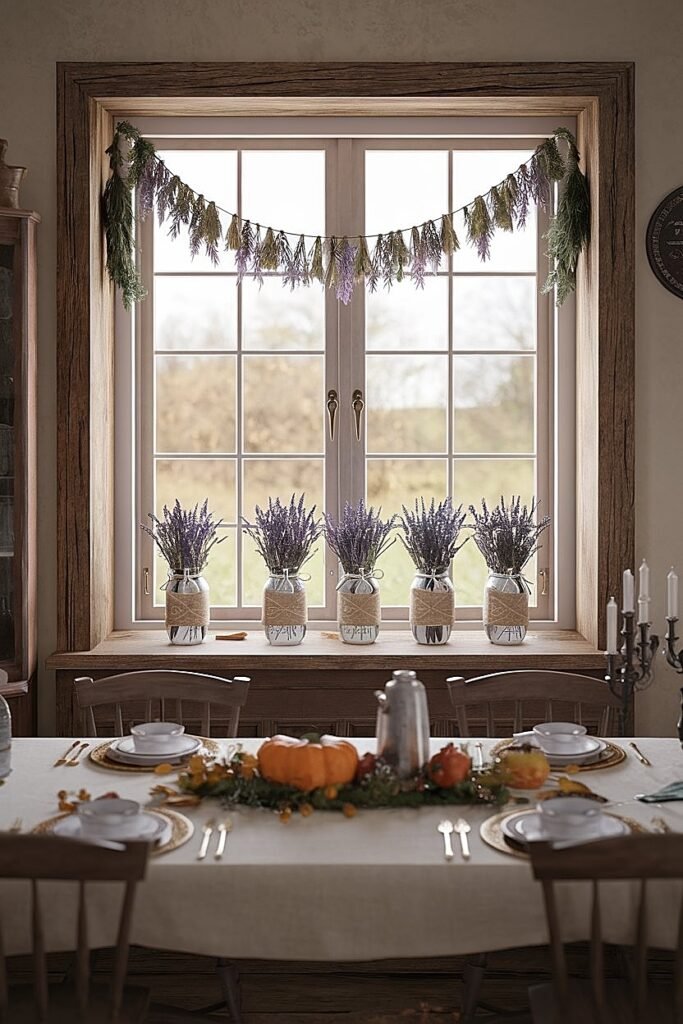
Windows dictate mood after 4 p.m. I start with a narrow olive or cedar runner along the sill, then stitch in short lavender arcs all pointing one direction. I position two or three frosted jars with warm LEDs—not scented wax—so the glass diffuses light onto the lavender. If the window has a mirror opposite, I lower the profile further to avoid visual noise; the reflection doubles whatever you put there.
I add a single ornament story per sill: mercury drops, matte white spheres, or small wooden stars. No rainbow. One metal finish, one neutral, lavender doing the talking. I set a pewter saucer with three tiny pinecones off-center to nudge the eye inward. Curtains? I keep them just kissing the ledge, not draped into the greenery. Air movement matters; windows draft, and you want a display that doesn’t migrate.
Build a slim green base, arc lavender consistently, light with warm LEDs in frosted glass, and keep a single ornament story with restrained pinecone accents; trim curtain contact points. There’s more texture play below—keep reading for twine and burlap ideas that feel winter, not farm stand.
Ideas for Using Twine and Burlap in Lavender Christmas Decor
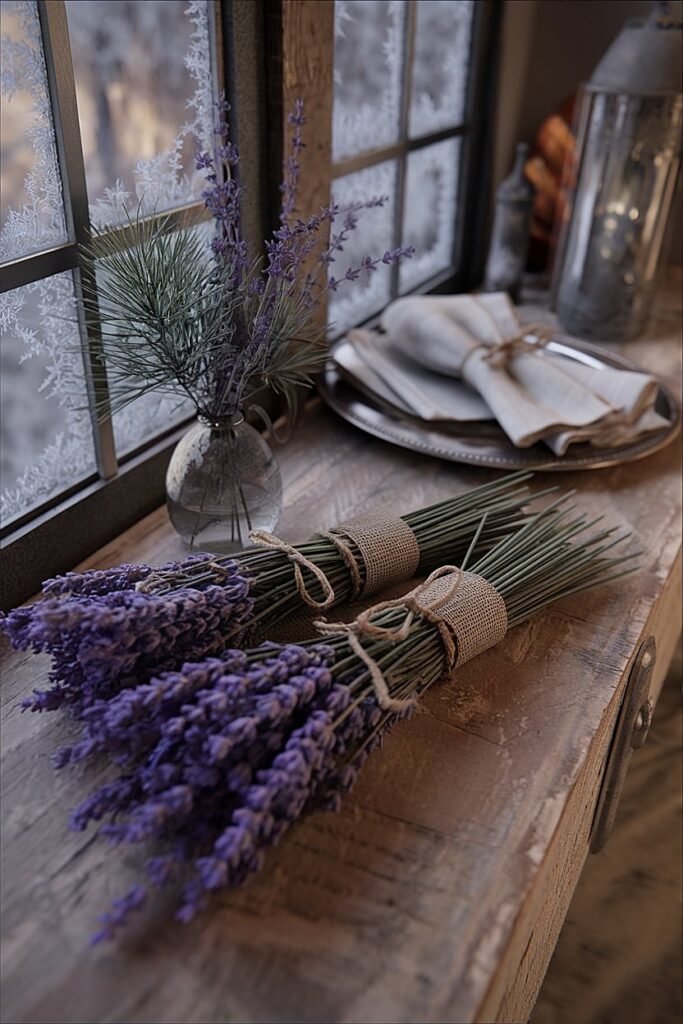
- Twine-Wrapped Candle Collars:
Wrap twine tightly around short glass votives, sealing ends with a micro dot of hot glue. Tuck a single lavender bud stem under the final wrap. The texture reads winter cabin without turning rustic-heavy, and the light warms the twine to honey. - Burlap Runner with Linen Overlay:
Lay a narrow burlap strip down the table, then top it with a thinner linen ribbon in bone. Stitch lavender at regular 12-inch intervals. The linen cleans the burlap visually, and the burlap grounds winter metals. - Gift Bundle Napkin Ties:
Swap rings for a twine cross-tie around folded napkins. Add one short lavender sprig and a cedar tip. It’s fast, photo-friendly, and layers scent only where guests choose to touch it. - Burlap-Wrapped Planter Sleeves:
Slide small pots into burlap sleeves and tie with twine and a pewter charm. Nestle lavender tufts and juniper berries at the lip. These become movable accents for shelves and mantels. - Twine Grid on a Tray:
Crisscross twine under a mercury tray like a loose grid. It prevents slide and adds a subtle rustic layer under high-shine metals, keeping the palette balanced. - Burlap Bow on Lantern Handles:
Trade velvet for a compact burlap bow at the lantern crown, pinning a micro lavender bundle to the knot. The scale stays tidy; the texture nods winter market. - Twine Ornament Hangers:
Replace metal hooks with twine loops on a small bowl of ornaments near the centerpiece. The natural fiber softens shine and ties back to lavender stems.
Use twine and burlap as texture stabilizers—small, deliberate touches that calm metals and frame lavender—never swamping surfaces. There’s more swap logic ahead—keep reading to trade pumpkins for pinecones without losing volume.
Ways to Replace Thanksgiving Pumpkins with Christmas Pinecones in Lavender Decor
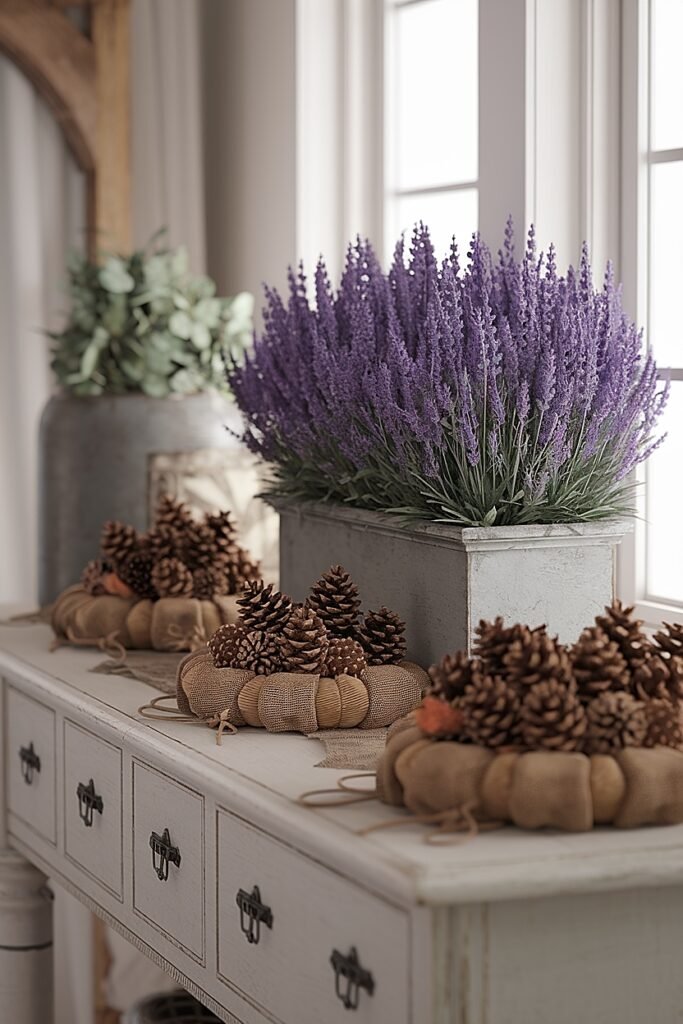
- Cloche Swap:
Remove a mini pumpkin under a cloche, replace with three sugar pine mini cones on linen. Add a lavender ring. Low, wintery, and protected from sleeves. - Plate Weight:
Trade a pumpkin stack for a trio of pinecones on a pewter saucer. Tuck cedar around the base and a short lavender sprig on top for lift. - Mantel Ends:
Where pumpkins anchored ends, seat clusters of small cones, wired to a cedar pad, then string a thin lavender garland between. The movement stays; the season changes. - Basket Fill:
Empty a bread basket of gourds and fill with cones plus juniper. Wire a lavender bundle to the handle. Mobile and practical. - Place Card Perch:
Swap pumpkin place card holders for a single cone with a slit cut into the top scale. Slide a name card and add one lavender bud stem for continuity.
Replace volume with clustered cones on cool surfaces, integrate cedar, and touch each swap with a hint of lavender so the narrative continues. There’s more hosting utility ahead—keep reading to style a buffet that flows under pressure.
How to Style a Rustic Buffet Table with Lavender and Christmas Accents
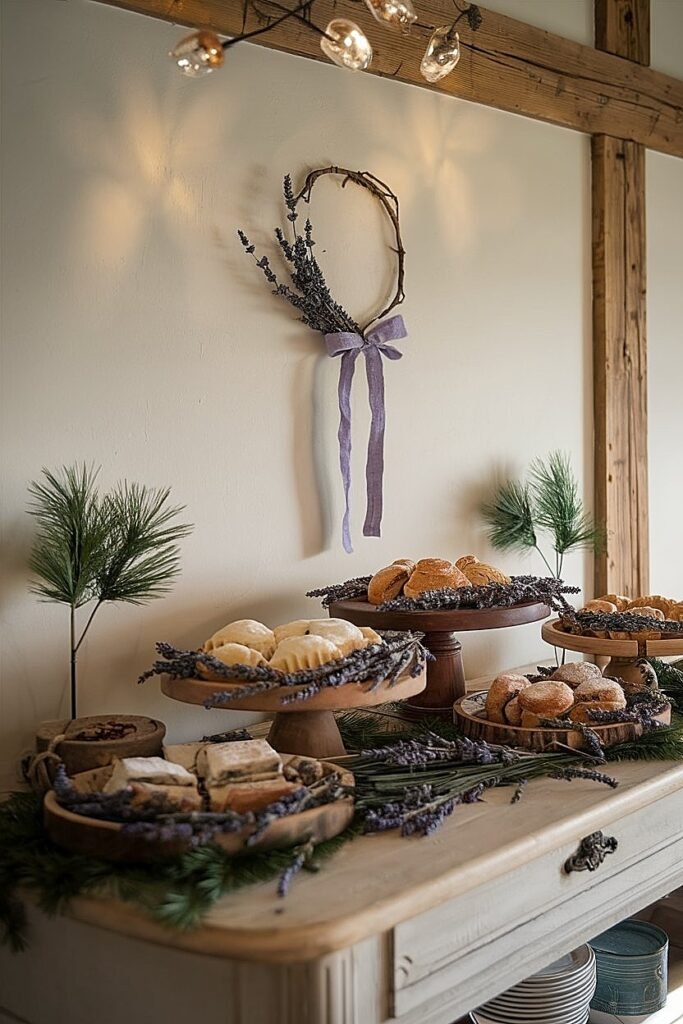
Buffets need speed and clarity. I ground the surface with two trays: one for glow (LED jars, mercury cups) and one for service tools. I run a narrow cedar strip along the back edge only, stitching in short lavender bundles so sleeves never graze stems. I park carafes at the far ends, never mid-lane, to keep reach paths clean.
Labels matter. I write small, bone cards and clip them to rosemary sprigs, then seat them on pewter clips at dish corners. I add a single bowl of cones and juniper berries at center as a visual anchor—non-edible and clearly decorative. If the line bottlenecks, I remove that bowl in one lift. Modularity keeps the table honest: pretty until it gets in the way, then gone in five seconds.
Anchor with trays, keep greens at the rear, recess lavender, deploy clear labels, and use removable accents; utility first, beauty threaded through. There’s more palette work to do—keep reading to tune color for winter clarity.
What Are the Best Color Tones to Transition Lavender Thanksgiving Decor for Winter
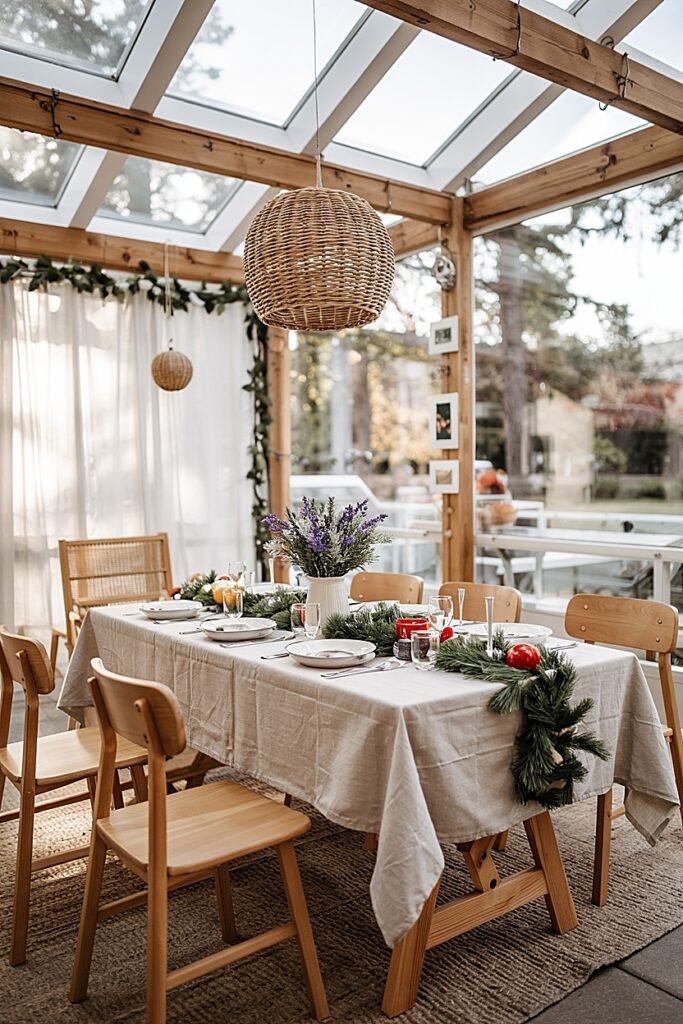
- Bone Linen:
Bone cools the scene without feeling sterile. It lightens lavender, supports pewter and mercury, and photographs clean at dusk. I use it for runners, napkins, and card stock so the whole room hums at the same frequency. - Pewter:
Cooler than brass, softer than chrome, pewter bridges lavender into winter elegance. It reflects candlelight without glare and makes pinecones feel intentional, not foraged last-minute. - Dusty Blue:
A quiet partner that deepens lavender’s bloom. In stoneware or ribbon accents, it cools straw tones, steadies cedar’s green, and reads like twilight when candles kick on. - Walnut:
Dark wood frames the cool palette, preventing the room from floating away. I add walnut boards, handled trays, or a single pedestal to ground sparkle and scent. - Mercury Glass:
Tiny doses of mercury multiply light and wake up lavender. I keep sizes small and heights low. The speckled finish keeps reflections soft, flattering faces and flowers equally.
Build a winter palette of bone, pewter, dusty blue, walnut, and small mercury hits; let lavender sit as the chromatic throughline. There’s more sensory tuning ahead—keep reading to layer fragrance without overwhelming supper.
How to Layer Fragrance Using Lavender, Pine, and Cinnamon
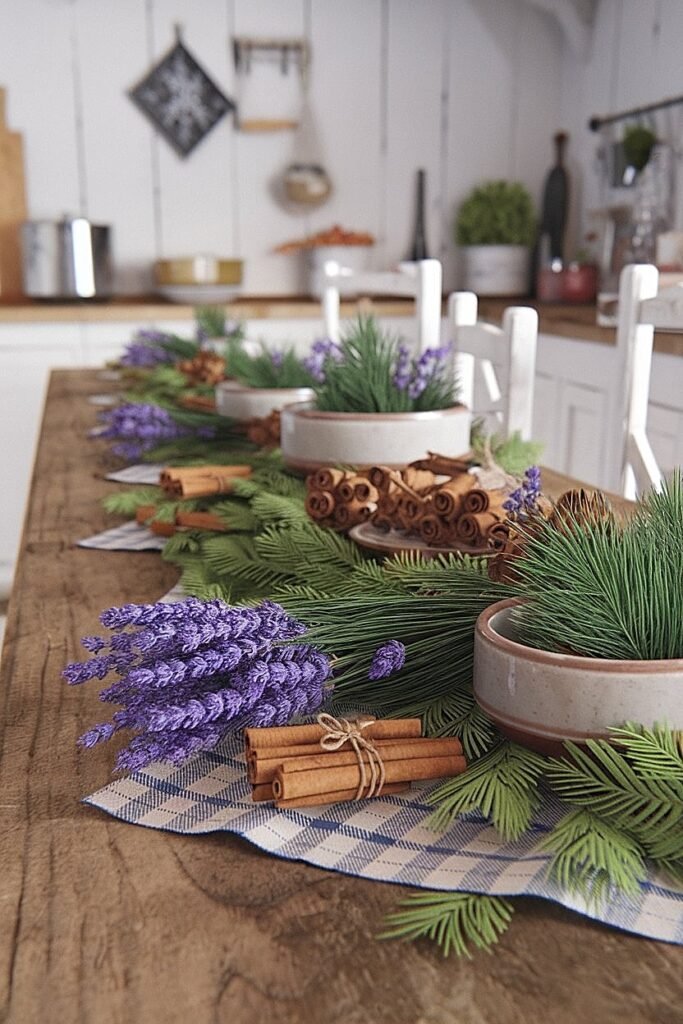
Scent stacking must be gentle. I keep lavender at base note level by burying bundles slightly and limiting visible stems. For pine, I rely on fresh cedar and fir tips—no heavy oils on the table. Cinnamon arrives off-stage: a simmer pot in the kitchen or a discreet sachet near the entry, never near food. The trio should suggest forest and hearth, not potpourri.
Timing matters. I air out the room 30 minutes before guests arrive, then light LEDs and place unscented candles. I let the greenery warm naturally under the lamps; that’s enough diffusion. If the space runs still, I crack a window by an inch for airflow. After dessert, I introduce a small cinnamon stick in a mug of hot water near the buffet to lift the mood without invading plates.
Keep lavender low and quiet, let real evergreen do pine’s work, and situate cinnamon away from the table; balance with fresh air and warm, unscented light. There’s more craft threaded throughout—keep reading back through sections to match these moves to your room’s light, traffic, and table size.
Conclusion
Transitioning lavender from Thanksgiving to Christmas isn’t a rebuild; it’s a refinement. Keep your base, soften lavender’s presence, and invite winter with short evergreen cuts, clustered pinecones, and a disciplined palette of bone, pewter, dusty blue, walnut, and shy mercury. Shift scent from harvest to alpine by lowering lavender volume, relying on fresh greens, and keeping cinnamon off the table. Ground buffets in trays, stage windows with low LEDs, and let your centerpiece glow, not shout. Do that, and your home will carry the calm of November straight into December—measured, luminous, and unmistakably yours.
This website contains affiliate links, and some products are gifted by the brand to test. As an Amazon Associate, I earn from qualified purchases. Some of the content on this website was researched and created with the assistance of AI technology.
